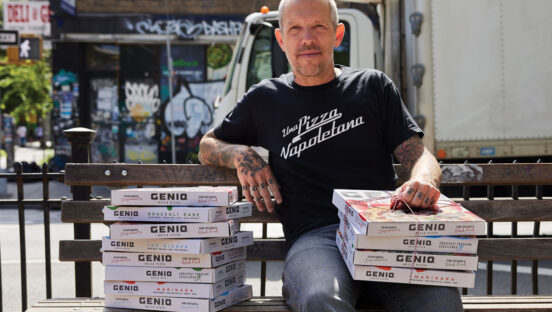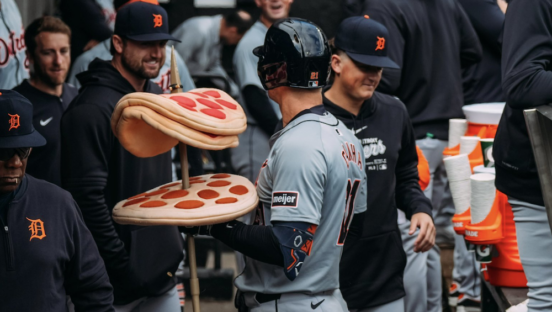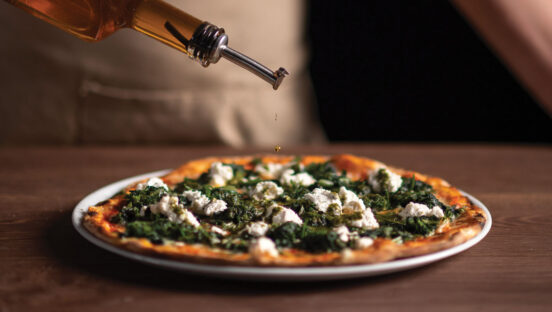Do pizza company leaders view their pizza box and other packaging as a marketing weapon? Some would reply, “YES.” In fact, however, most of them do not view it that way.
Most pizza companies ignore packaging as a tool and, instead, view it as merely a carrying vessel. That being the case, the driving factor behind packaging development is cost reduction. In the pizza industry, the locus of packaging development resides in purchasing rather than in marketing. We believe that by viewing packaging as a marketing weapon rather than as a carrying vessel a company will greatly enhance its bottom line. Here's why … and how to do it.
The Two Dimensions of Packaging
When most pizzeria owners think of packaging, graphics is what comes to mind. However, packaging actually consists of two dimensions: graphics and structure. Structure is the architecture and graphics is the paint job. Most tend to ignore structure as a player in package design and marketing strategy. Unfortunately, viewing a corrugated pizza box as merely “cardboard with printing” shackles our ability to maximize packaging's effectiveness as a marketing tool.
Still, that's the way many pizza industry executives view packaging. They see it as “just a box.” They cite focus group research, which appears to support the notion that pizza-buyers don't care about the box. So they continue on with the same carton they've had for the last 10, 20, or 30 years, and which 5,000 of their competitors continue on with as well. But is that a correct conclusion? Is that the most profitable perspective?
Scientific research tells us that packaging influences consumer's perception. So is it likely that consumers are somehow immune to being influenced by pizza packaging? No way! Interestingly, at least some research has apparently suggested a connection between the packaging and perceived product quality. Buried in the February 28, 2000, issue of Nation's Restaurant News is this revealing quote: “…said Tim McIntyre, vice president of corporation communications for Domino's Pizza, ‘our research indicates that in blind taste tests we do as well or better than our competitors. But when you put the same pizza in a Domino's box, the perception of our quality goes down.’”
Pre-purchase and Post-purchase Impact
When most folks think of packaging's impact, they think of what they encounter as they roam a supermarket or department store. This is pre-purchase impact. However, there is another form of packaging interaction: Post-purchase impact. It occurs after the purchase and, typically, in the consumer's home.
The Post-purchase Bonanza
Amazingly, except for the actual pizza, your pizza packaging is the vehicle of greatest exposure and consumer interaction in your business! That's because (a) the packaging has the highest frequency of customer contact of any element in your business and (b) it has the longest duration of customer contact of any element in the business. Here's why that is.
Customer Contact Frequency: For each delivery/carry-out pizza sold, an average of 2.5 persons have contact with the box. So a pizza store that sells 50,000 pizzas annually has 125,000 customer contacts per year with the box (50,000 X 2.5).
Customer Contact Duration: With each purchase, a typical consumer spends at least 10 minutes viewing and interacting with your packaging! (About 20 percent of them even save the box for another 12 hours in the refrigerator.) In that period the customer views it, reads it, feels it, transports it and operationally interacts with it. Yes, believe or not, the typical consumer spends more time viewing and interacting with your pizza box than with all of your advertising, signage, building, and service staff put together.
So what's the result of these two factors combined? For a pizza store that sells 50,000 pizzas annually, its box garners a whopping 1,250,000 minutes, or 20,833 hours, of customer contact time per year. Nothing else even comes close.
Multi-dimensional Marketing Impact
Packaging impacts sales via brand building, differentiation building, impression building and quality building. In brand building, we use packaging to get consumers to associate our product with a particular name or trademark. In differentiation, we use it to define our point of difference and drive it into the consumer psyche. With impression building we use it to create a particular overall positive impression that we want consumers to have of our enterprise. In effect, impression building is the process of attaching positive feelings to our brand. How can packaging be put to work in impression building? One way is to apply box graphics that reinforce the impression we want to create.
Quality-building
We measure quality in two dimensions: (1) as customer perceptions and (2) as product characteristics. Ultimately, perception is all that matters. We should view the second dimension merely as a way to achieving desired results in the first. Interestingly, packaging plays an important role in both dimensions.
Quality Enhancement Issues
When pizza company executives speak of product quality, it's ingredients and pizza-making methods that they're usually referring to. Fact is, packaging plays a crucial role, as well. The point to realize is that what counts is not what a pizza is like when it comes from the oven but, rather, what it's like when being eaten. The difference can be substantial. So when we speak of quality we're talking about quality at the point of consumption, as opposed to the point of production.
Here are some issues to illustrate. A quality pizza is one that's cut all the way through. A half-cut pizza where a customer must rip one slice from another detracts from the pizza-eating experience. Further, a quality pizza is one in which the slices contact one another, or aren't spread apart. Slice spreading also occurs when a pizza that's cut on a peel or board is slid into the box. When slices separate, it not only looks sloppy but it also allows sauce and cheese to ooze into the space between slices. Further, when a consumer picks up such a slice, the cheese and toppings often slide off the crust and remain in the box. Also, quality pizza is one that's in its original shape (typically, round) when it arrives at the customer's door. Finally, a quality pizza is one that arrives hot and remains hot. Choose a packaging option that delivers a quality product.
Promotion-building
For decades pizzeria operators have affixed advertising pieces, or boxtoppers, to their pizza boxes. What the customer receives is a box with a wrinkled, crookedly positioned piece of paper glued on top of a company logo. In removing the paper it gets torn, and remaining is an ugly little glue spot with a paper strip attached. What impression does this create?
To overcome this problem, one strategy is to create box graphics designed to integrate with a particular-size boxtopper. For optimal impact, attach the boxtopper with removable glue or tape and position it with care. Another strategy is to use a boxcard instead of a boxtopper. A boxcard is a business-card size piece containing a promo offer. Instead of gluing it to the cover, it's slipped between the side panels of the box. When the customer opens the box the card flips out onto the table.
Superior Side-item Packaging
The recent menu explosion in side items (breadsticks, chicken wings, poppers, etc.) ushers in the need for economical, efficient, crush-resistant side-item packaging. Many of these carton concepts contain exciting, unique features and designs. For example, some are equipped with a separate compartment for sauce cups, as required by some health departments.
New Products
Box carriers are a new packaging item. These ‘carriers’ are like a sideless bag that allows you to place multiple boxes in a sling-like carrier that has a handle. Your drivers or customers carry the pizzas just as if they were in a bag and they can have your logo or name printed on the side.
PCE is another Hot Feature of the Future. PCE stands for Pizza Carton Elevation. It results from placing legs on a corrugated pizza carton (previously referred to as Hot-legs in a past issue of PMQ). Virtually any style of carton can be equipped … including your current pizza box. Here's how PCE works. In a customer's home, a pizza in a non-legs carton experiences 33 percent greater heat loss than a pizza in a legs-equipped carton. Also, without legs, the box bottom absorbs condensation that forms on a tabletop, whereas with a legs-equipped box a tabletop stays dry. Finally, a package with a soggy, water-soaked bottom panel projects a low-quality image.
Square vs. Non-square
Originally all pizza boxes were square. Today, most of them still are. However, circa 1988, a curious thing happened — the first non-square pizza carton hit the market. It was an 8-sided, or octagon, box dubbed the “octabox.” It was picked up by Domino's Pizza and used by the chain until about 1996, at which time it was dropped for a D-style hexagon carton. Which is best — square or non-square? Actually, the answer isn't so simple, because square boxes vary from type to type as do non-square boxes. However, it's possible to make a few generalizations.
Advantages of Square Boxes: A square-shape box has three advantages over a non-square box. First, a square shape is what people traditionally associate with a pizza box. Second, a square shape provides a maximum of cover area, which affords maximum surface area for printing. Third, a square box has four open corner spaces for holding extra items like sauce cups, garnishes, and the like.
Drawbacks of Square Boxes: The main drawbacks of square-shaped cartons are that (a) the four open corner spaces allow pizza-sliding, or slice separation, during delivery and (b) the box contains a maximum amount of air space, which tends to promote maximum heat loss. However, there are ways of reducing pizza sliding in a square box, such as by incorporating anti-slide cover flaps into a carton.
Advantages of Non-square Boxes: A non-square box has some advantages over a square box. First, a non-square box is “new and different.” It's also a way of clearly differentiating your carton from that of the competition. Second, a non-square box accommodates creative cover shapes and opens the door to high-impact box structures. Third, due to the diagonal panels, a non-square box reduces pizza sliding, or slice separation. Fourth, a non-square box has a smaller air space, which tends to promote heat conservation.
Drawbacks of Non-square Boxes: The main drawbacks of non-square cartons are that (a) in certain design configurations they can project an unconventional image, which might not correlate with the desired image of a pizza company, (b) the covers of non-square boxes tend to have slightly less surface area for printing, and (c) non-square boxes have diminished corner space for packing extra items. However, with creative design, all three of these drawbacks can be reduced or eliminated.
Paper vs. Plastic: Pizzeria, restaurant, and foodservice packaging comes in two basic materials: Paper and plastic. Plastics comprise a host of synthetically made moldable materials. The advantage of plastic packaging is that it can be molded into special shapes and colors and can be designed to be 100 percent leak-proof. Paper packaging comprises two main types: Paperboard (ex. chipboard) and corrugated board. The advantage of paper packaging is that it never develops product-sogging condensation build-up inside the carton, can support stunning graphics and Graphics-Structure Integration, and also is usually more cost-effective. Corrugated board is far-and-away the most prevalent material used in pizza packaging today. So the rest of this discussion pertains to corrugated pizza boxes.
Corrugated board comes in many forms. The most common is single wall board, also known as double face board. It's what's used for most pizza boxes. It consists of two outer sheets of flat paper, called facings or liners, glued to a fluted, or corrugated, inner sheet, called medium. The paper used for the facing or liner is called linerboard.
B-flute vs. E-flute
Corrugated board can be produced in various thicknesses or heights. This is accomplished by shaping the inner paper of the board into any of several flute heights during the production, or corrugating, process. The higher the flute, the thicker the corrugated board. To designate the various flute heights, or board thickness, the corrugated paperboard industry applies letters and has derived designations such as A-flute, B-flute, C-flute, E-flute, and so on.
Most corrugated pizza cartons come in either B-flute or E-flute board. B-flute board is about 1/8-inch thick, E-flute is about 1/16-inch thick, or half as much. Some folks assume that B-flute, because it's thicker, comes with heavier paper, but that's not necessarily so. The flute size has nothing to do with paper thickness, or weight. The advantages of B-flute are that (a) it tends to warp less from pizza steam than does E-flute and (b) some folks believe that the thicker board connotes higher quality. The advantages of E-flute are that (a) it saves almost 50 percent in box blank storage space over B-flute and (2) it tends to print up slightly better.
Some folks also assume that B-flute, because it's thicker, retains pizza heat better. However, research by at least one box manufacturer refutes this.
Rolf Wilken, owner of 17 Eureka! Pizza locations in and around Arkansas, switched from B-flute boxes to E-flute and saved over $100,000 dollars in packaging. “Each of our locations sells an average of 2,300 pizza per week,” Rolf said. “I actually found the E-flute box to be a better insulator. We ran a test where we put pizzas in both the B-flute and E-flute boxes and let them sit for 20 minutes because that is how the customer gets it. Then, we inserted a probe thermometer and discovered the heat to be higher in the E-flute. But the box is flimsier, so we use lid supports to support the cover and protect the pizza. However, even with the additional costs of the supports, it still saved us money to switch.”
Cost Reduction
We believe that packaging's greatest profit-building potential lies in the marketing, or sales-building, area. However, many pizza company executives view packaging's profit-boosting potential in terms of cost reduction. In fact, these two pursuits aren't always mutually exclusive.
Two Basic Cost-reduction Strategies: The biggest factor in a pizza carton's cost structure is material. In a corrugated folder-type pizza box, material comprises about 70 percent percent of its total cost. In a clamshell-type box, it comprises around 50 percent of total cost. So, clearly, a large opportunity for cost reduction lies in reducing material cost. There are two basic strategies for reducing material cost: (1) use a lower-cost corrugated board and (2) use less board in manufacture of the box blank.
Strategy 1: To reduce the cost of the board you can do one or a combination of three things:
- Switch to a fewer number of print colors — ex. if you're currently having your box printed with two colors, go to one color.
- Switch to a lighter weight, or thickness, of paper for either of the liners (the outer papers) or for the medium (the inner fluted paper) used in making the board. However, be advised that this tends to reduce the board's strength, or rigidity.
- Switch from white (bleached) paper to kraft (brown) paper on one or both of the liners.
Strategy 2: To reduce the amount of board used in manufacture of the box blank, you must switch from your current box structure to a new board-saving structure. There are two categories of structural changes: (1) minor tweaks to a current structure and (2) adoption of a totally new structure. Minor tweaks generally produce a cost savings in the range of one percent to three percent. However, they often have the advantage of not “disrupting” store operations. For more savings than that, a totally different structure, or different box concept, is usually required.
For clamshell-type cartons that are used for packaging side items such as breadsticks and the like, it's often possible to effect a cost savings of 30 percent or more by replacing the clamshell carton with a comparable-sized folder style carton.
Bleached Paper vs. Unbleached
Rolf, with Eureka! Pizza, also discovered advantages to the paper used in his boxes. “We made a big deal out of the E-flute boxes because they use less paper and are environment-friendly and the fact that we switched to unbleached paper in the boxes,” Rolf said. “By using unbleached paper, we saved $20,000 a year in packaging. The bleached paper shows less grease from the pizza, but so far, it hasn’t been an issue.”
Folding vs. Non-folding
Regarding paper packaging for pizza, cartons can be further classified into two types: Those requiring folding or set-up, called folder or folding cartons, and those that don't, typically called clamshells. The obvious advantages of clamshell cartons are (a) they don't require in-store folding time and (b) they consume less storage space than do stacks of pre-folded boxes. The advantages of folder cartons are that (a) they're substantially less costly than clamshells (as much as 30 percent or more), (b) they tend to be sturdier or have greater crush-resistance than clamshells, and (c) they can be set up on their side on a shelf (such as above a cut-table).
Sauce Cup Separation Issue
Recently health departments have been requiring that all items handled by human hands be separated from contact with any ready-to-eat food product. So it may be that your Health Department may require that sauce cups put in the carton with the pizza have a physical barrier between the cup and the pizza. If that's the case, you may have to place a paper between the cup and the pizza.
In Conclusion
Packaging has the most exposure of all marketing assets and yet is probably the most overlooked of all marketing tools. Recall the cereal box: You pour the cereal, sit down to eat it and read the box. A similar situation exists with the pizza package. This makes the box a perfect place to put advertising, co-op promotions, specials, your restaurant’s history, or your logo in Graphics-Structure Integration.
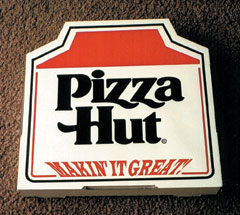 |
This box shows how GSI (Graphics-Structure Integration) can be used to turn an ordinary pizza box into a dramatic 3-dimensional embodiment of a company logo. This single mock-up using a Pizza Hut graphic was made for illustration and has not been manufactured, used, or sold. |
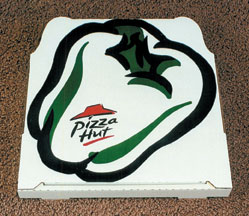 |
Using GSI, the rear corners of this box are given an “organic” contour to complement the organic-looking cover graphic. This single mock-up using a Pizza Hut graphic was made for illustration and has not been manufactured, used, or sold. |
 |
This mockup shows how the shape and cover graphic of a pizza box can be used to pound home a company’s main message. This single mock-up using a Little Caesars graphic was made for illustration and has not been manufactured, used, or sold. |
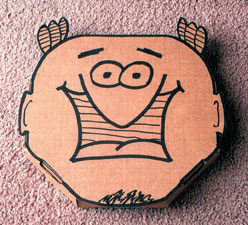 |
Using GSI (Graphics Structure Integration), a pizza box is transformed into the smiling visage of a company mascot. This single mock-up using a Little Caesars graphic was made for illustration and has not been manufactured, used, or sold. |
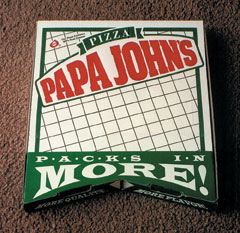 |
A box with enlarged front corners (for holding even more goodies) is combined with a complementary graphic to drive home the point. This single mock-up using a Papa John’s graphic was made for illustration and has not been manufactured, used, or sold. |
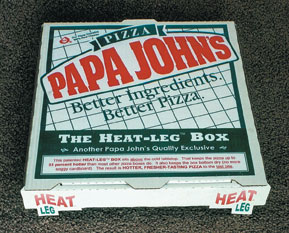 |
This mockup shows how heat-legs (a.k.a. PCE) can be used to enhance a company’s benefit bundle and point of differentiation. This single mock-up using a Papa John’s graphic was made for illustration and has not been manufactured, used, or sold. |












